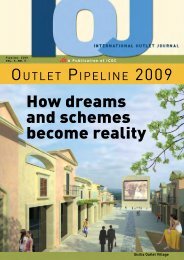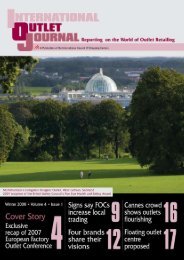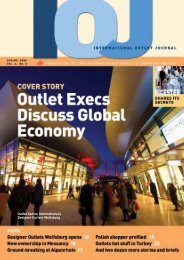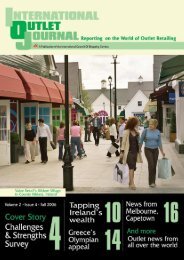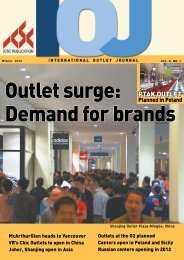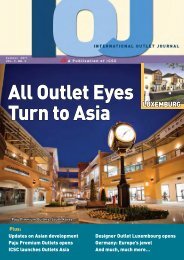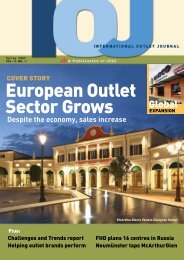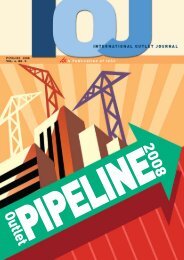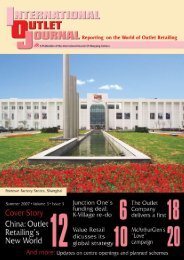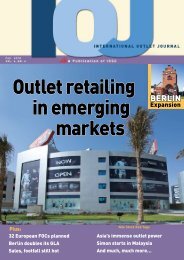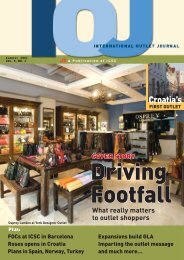percassi's conquest: Sicilia Fashion Village - Value Retail News
percassi's conquest: Sicilia Fashion Village - Value Retail News
percassi's conquest: Sicilia Fashion Village - Value Retail News
Create successful ePaper yourself
Turn your PDF publications into a flip-book with our unique Google optimized e-Paper software.
EOC RECAp<br />
(Continued from page 10)<br />
Desigual, we dress people, not bodies.”<br />
About half of their stores are outlet<br />
stores. Showing pictures of outlet store<br />
interiors in Belgium and Spain, Rouras<br />
explained that it<br />
was important<br />
that the customer<br />
be able to identify<br />
the brand in every<br />
location. “Otherwise,<br />
it is not the<br />
same shopping<br />
experience for the<br />
Rouras<br />
customer,” he said,<br />
adding that another<br />
aspect that makes outlet shopping different<br />
is that “people have money to spend,<br />
but not the time. Therefore, customer<br />
service at an outlet center must be of the<br />
same high quality as on high street.”<br />
Desigual is following a four-part growth<br />
strategy that includes outlet stores, outlet<br />
events (for now-or-never purchases),<br />
urban outlets for customers who cannot<br />
get to out-of-town centers, and full-price<br />
stores with an outlet area. With this strategy<br />
the company aims to reach the broad<br />
cross-section of shoppers that it describes<br />
as its target group. “The goal,” said<br />
Rouras, “is to have one Desigual garment<br />
hanging in every wardrobe.”<br />
n n n<br />
A<br />
t lindt, the personality is in<br />
the chocolate. According to<br />
Pierenrico Barbesino, sales<br />
and marketing director of SelectTrade,<br />
which works in partnership with Lindt,<br />
“What makes Lindt chocolate different<br />
from any other<br />
is the individual<br />
effort that goes<br />
into each chocolate.<br />
Each one is<br />
a unique creation,<br />
‘con personalita.’”<br />
Nearly threequarters<br />
of<br />
barbesino branded Lindt<br />
stores in Italy are located in outlet centers.<br />
According to Barbesino, “A certain<br />
‘wow’ effect is important for stores in<br />
outlet centers because shoppers don’t<br />
usually expect to find a chocolate shop<br />
there. If shoppers buy chocolate at an<br />
outlet center, it is an impulse buy.”<br />
During the summer months, the<br />
stores also sell ice cream, and during the<br />
winter, hot chocolate drinks made of<br />
Lindt chocolate are on offer – complete<br />
12 InteRnatIonal outlet JouRnal WINTER 2011<br />
with a chocolate spoon.<br />
Customer education is also key. “It is<br />
important to let people experience premium<br />
chocolate,” explained Barbesino,<br />
and to allow them to develop a taste<br />
for exquisite chocolate. “The customer<br />
isn’t walking into a bar,” he said. “The<br />
customer is entering a Lindt world.”<br />
Spotlight on<br />
China, Russia<br />
and Egypt<br />
is on fire,” said<br />
Chris Milliken, commercial<br />
“China<br />
director of Freeport, “but<br />
it is easy to burn your fingers.”<br />
China has about one-fifth of the<br />
world’s population and within a decade<br />
is expected to be the world’s largest<br />
economy. Despite<br />
intense interest in<br />
the region, this potential<br />
outlet haven<br />
also has some significant<br />
drawbacks,<br />
he said.<br />
Government<br />
ownership of land<br />
and proper center<br />
milliken<br />
management are two major hurdles.<br />
Also, about 80 percent of the population<br />
has to be written off as potential outlet<br />
shoppers. Finally, there is the pervasive<br />
and difficult issue of counterfeit goods.<br />
But if outlet developers and retailers<br />
are interested in China, China is also<br />
interested in outlets. China is among<br />
the top three markets in luxury goods,<br />
second only to Japan, and ahead of the<br />
United States. More than 25 so-called<br />
outlet centers are already operating in<br />
China, many of which are enormous.<br />
One center in Shanghai boasts more<br />
than 100,000 m 2 . “If an outlet center<br />
isn’t big in China, it may not even be<br />
on the map,” Milliken said, adding that<br />
China has considerable potential but<br />
considerable risks, too.<br />
n n n<br />
In Russia, said Neil Thompson, CEO<br />
of <strong>Fashion</strong> House Development, “outlets<br />
are the next logical step.”<br />
The country has a population of 140<br />
million, and three-quarters of its residents<br />
live in urban areas. In the last decade Russians<br />
have embraced Western consumer<br />
culture. Almost all luxury brands are<br />
present. “People aspire to brands more<br />
than they do in<br />
the United States,”<br />
Thompson said,<br />
“and they are an essential<br />
part of outlet<br />
shopping,” especially<br />
since nearly half of<br />
shoppers base their<br />
purchasing decisions<br />
on brand names.<br />
The cultural impression of a shopping<br />
experience is also critical. “If people<br />
are going to a place they have to travel<br />
60 minutes to get to, they don’t want to<br />
walk around outdoors,” said Thompson.<br />
Mixed-use centers are also popular.<br />
Yet outlet development so far is “scattered<br />
and improvised,” Thompson said.<br />
Consumers still view designer outlets<br />
as discount centers; there are problems<br />
with licensing and franchises; and finally,<br />
available data, for instance on turnover,<br />
are often unreliable. But with the Russian<br />
shoppers’ appetite for brands at bargain<br />
prices, there is clearly potential.<br />
n n n<br />
Egypt, said Ibrahim Kamal, managing<br />
director of Nile Stock, “isn’t quite ready<br />
for an outlet center.”<br />
But Nile Stock is taking the first steps<br />
in that direction. The company originally<br />
developed from a family-owned textile<br />
business (Nile Tricot), which, faced<br />
with excess stock,<br />
opened the Nile<br />
Stock factory outlets.<br />
There are now<br />
a total of seven<br />
outlets with a retail<br />
area of 4,000 m 2 .<br />
Last year Nile Stock<br />
launched Red Tags,<br />
a 2,000-m 2 flag-<br />
Thompson<br />
Kamal<br />
ship department store, and the first of its<br />
kind in Egypt, where shoppers can find<br />
international brands at affordable prices.<br />
Egypt is the most populated country<br />
in the Arab world with 78 million people.<br />
With its robust economy, increasing<br />
retail sales and an emergent middle class<br />
and tourism, the shopping center culture<br />
is already firmly established. Since<br />
2003 there has also been an influx of<br />
international brands into the country.<br />
“Although brand interest is increasing,”<br />
Kamal said, “it is still too soon for<br />
outlet centers to operate successfully in<br />
Egypt.” c





